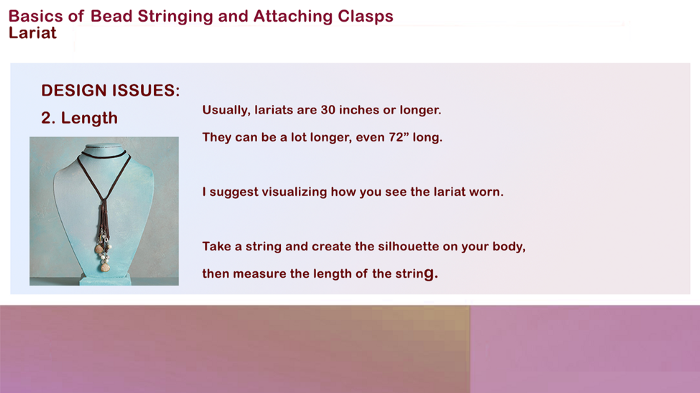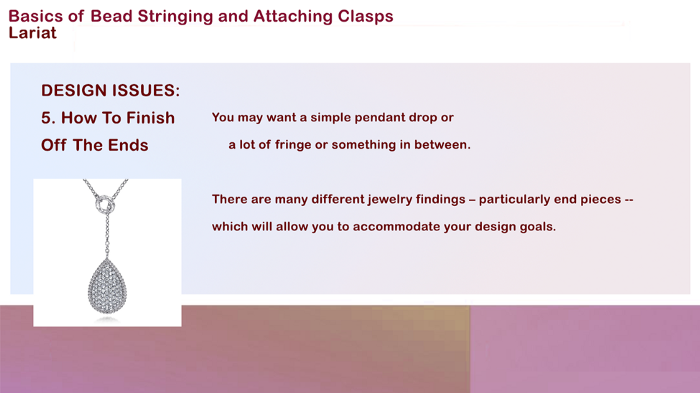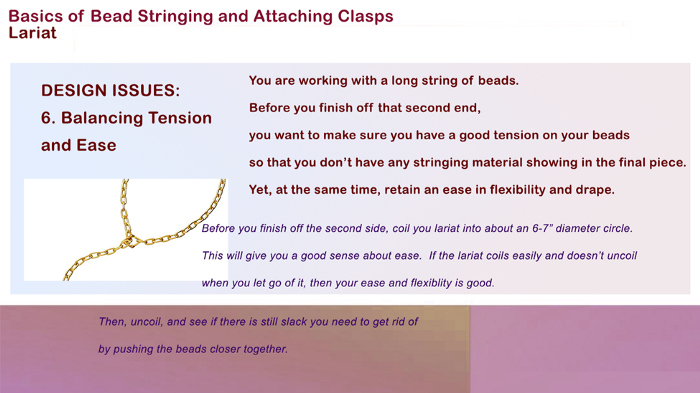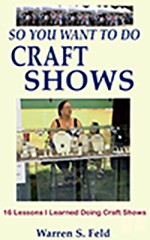BASICS OF BEAD STRINGING AND ATTACHING CLASPS: The Lariat
Posted by learntobead on February 23, 2023

LARIATS
Materials needed:
.014”/.015” or .018”/.019” cable wire
enough of a mix of seed beads and Czech glass beads (3mm — 6mm in size) to
cover 36” of cable wire
crimp beads
horseshoe wire protectors
crimp covers
end caps or bead caps or cones (2 of them)
head pins (2 of them)
2 decorative beads, perhaps teardrop shaped, about 18mm in size
Tools needed:
crimping pliers
chain nose pliers
flat nose pliers
scissors
side cutters or flush cutters
bead board
ruler
paper
pencil
work surface
A lariat is a long, usually beaded, string, which a person wraps around their neck,
and lets the tails hang.

The tails can be tied in a loose overhand knot together.
Or one tail may have a large loop or ring or donut, through which the other tail slips into.
Or the lariat can be wrapped around the neck once or twice, and the tails allowed to dangle.
With some designs, the part of the lariat which becomes the focal point, can be varied.
Lariats may be all beaded, partially beaded, or not beaded at all.
In fact, this versatility is the popularity of the lariat. You can create many different silhouettes. And you do not have to bother with a clasp.
And you can make a multi-strand lariat, if you want. The design choices are endless.

DESIGN ISSUES
The design issues associated with the lariat include:
1. Stringing material
2. Length
3. Whether to use a fixed connection point
4. Silhouette flexibility
5. Finishing off the ends
6. Maintaining the tension on your beads, while allowing sufficient ease

STRINGING MATERIAL
Many different types of stringing materials will work well with lariats.
You can use:
· Needle and thread.
· Cable wire
· Bead cord
· Leather or waxed cotton
· Leather lace
· Chain
· Even fabric or ribbon

LENGTH
Usually, lariats are 30 inches or longer.
They can be a lot longer, even 72” long.
I suggest visualizing how you see the lariat worn. Take a string and create the silhouette on your body, then measure the length OF THE STRING.

WHETHER THERE IS A FIXED POINT OF CONNECTION, SUCH AS A LOOP OR RING OR DONUT ON ONE SIDE
This is a personal design choice.
Many lariats do not have fixed points of connection.
One option is to fold the lariat in half, and use the bend as the point of connection, and slip the two legs through the bend.
Another option is to tie a loose overhand knot with the two legs.
Still another option is to wrap it around the neck, and, let the legs dangle.
If you have a point of connection on one side, then you need to be sure that the other tail will be able to slip through the opening.

SILHOUETTE FLEXIBILITY
As a designer, you need to anticipate the various ways your design may be worn.
Then ask yourself:
· Will my design be long enough to accommodate the various ways i visualize it getting worn?
· Is the arrangement of beads, given the various silhouettes, optimal?
· Given the various silhouettes, will the lariat drape well and move in place with the person as the person moves?

HOW TO FINISH OFF THE ENDS
You may want a simple pendant drop or a lot of fringe or something in between.
There are many different jewelry findings — particularly end pieces — which will allow you to accommodate your design goals.

MAINTAINING THE TENSION ON YOUR BEADS, WHILE ALLOWING SUFFICIENT EASE
You are working with a long string of beads.
Before you finish off that second end, you want to make sure you have a good tension on your beads so that you don’t have any stringing material showing in the final piece. Yet, at the same time, retain an ease in flexibility and drape.
Towards this end, before you finish off the second side, coil your lariat into about an 6–7” diameter circle. This will give you a good sense about ease. If the lariat coils easily and doesn’t uncoil when you let go of it, then your ease and flexibility is good.
Then, uncoil, and see if there is still slack you need to get rid of by pushing the beads closer together. If there is slack, you’ll notice a lot of the stringing material showing.
If you need to tighten the tension, do so, then coil again, so that you are finding that optimum tension and ease.
____________________________________
CONQUERING THE CREATIVE MARKETPLACE: Between the Fickleness of Business and the Pursuit of Design

How dreams are made
between the fickleness of business
and the pursuit of jewelry design
This guidebook is a must-have for anyone serious about making money selling jewelry. I focus on straightforward, workable strategies for integrating business practices with the creative design process. These strategies make balancing your creative self with your productive self easier and more fluid.
Based both on the creation and development of my own jewelry design business, as well as teaching countless students over the past 35+ years about business and craft, I address what should be some of your key concerns and uncertainties. I help you plan your road map.
Whether you are a hobbyist or a self-supporting business, success as a jewelry designer involves many things to think about, know and do. I share with you the kinds of things it takes to start your own jewelry business, run it, anticipate risks and rewards, and lead it to a level of success you feel is right for you, including
· Getting Started: Naming business, identifying resources, protecting intellectual property
· Financial Management: basic accounting, break even analysis, understanding risk-reward-return on investment, inventory management
· Product Development: identifying target market, specifying product attributes, developing jewelry line, production, distribution, pricing, launching
· Marketing, Promoting, Branding: competitor analysis, developing message, establishing emotional connections to your products, social media marketing
· Selling: linking product to buyer among many venues, such as store, department store, online, trunk show, home show, trade show, sales reps and showrooms, catalogs, TV shopping, galleries, advertising, cold calling, making the pitch
· Resiliency: building business, professional and psychological resiliency
· Professional Responsibilities: preparing artist statement, portfolio, look book, resume, biographical sketch, profile, FAQ, self-care
548pp.
SO YOU WANT TO BE A JEWELRY DESIGNER
Merging Your Voice With Form

So You Want To Be A Jewelry Designer reinterprets how to apply techniques and modify art theories from the Jewelry Designer’s perspective. To go beyond craft, the jewelry designer needs to become literate in this discipline called Jewelry Design. Literacy means understanding how to answer the question: Why do some pieces of jewelry draw your attention, and others do not? How to develop the authentic, creative self, someone who is fluent, flexible and original. How to gain the necessary design skills and be able to apply them, whether the situation is familiar or not.
588pp, many images and diagrams Ebook , Kindle or Print formats
The Jewelry Journey Podcast
“Building Jewelry That Works: Why Jewelry Design Is Like Architecture”
Podcast, Part 1
Podcast, Part 2
PEARL KNOTTING…Warren’s Way
Easy. Simple. No tools. Anyone Can Do!

I developed a nontraditional technique which does not use tools because I found tools get in the way of tying good and well-positioned knots. I decided to bring two cords through the bead to minimize any negative effects resulting from the pearl rotating around the cord. I only have you glue one knot in the piece. I use a simple overhand knot which is easily centered. I developed a rule for choosing the thickness of your bead cord. I lay out different steps for starting and ending a piece, based on how you want to attach the piece to your clasp assembly.
184pp, many images and diagrams Ebook, Kindle or Print
SO YOU WANT TO DO CRAFT SHOWS:16 Lessons I Learned Doing Craft Shows

In this book, I discuss 16 lessons I learned, Including How To (1) Find, Evaluate and Select Craft Shows Right for You, (2) Determine a Set of Realistic Goals, (3) Compute a Simple Break-Even Analysis, (4) Develop Your Applications and Apply in the Smartest Ways, (5) Understand How Much Inventory to Bring, (6) Set Up and Present Both Yourself and Your Wares, (7) Best Promote and Operate Your Craft Show Business before, during and after the show.
198pp, many images and diagrams, Ebook, Kindle or Print
___________________________________________
This entry was posted on February 23, 2023 at 1:42 am and is filed under Art or Craft?, bead stringing, bead weaving, beads, beadwork, craft shows, design management, design thinking, jewelry design, jewelry making, Learn To Bead, pearl knotting, Stitch 'n Bitch, wire and metal. Tagged: bead stringing, lariat, necklaces. You can follow any responses to this entry through the RSS 2.0 feed. You can leave a response, or trackback from your own site.








Leave a comment